Effective Techniques for Cleaning Diamonds and Jewelry
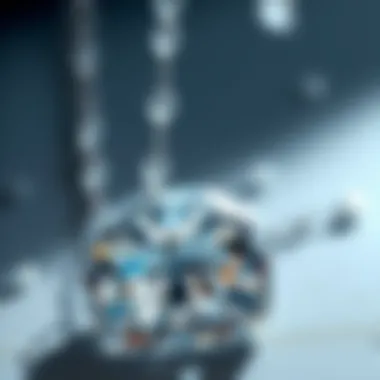
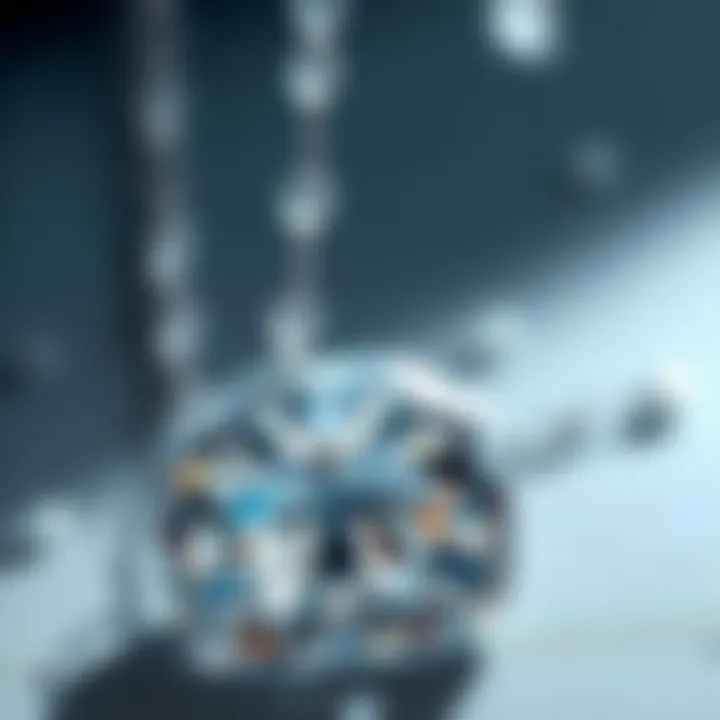
Intro
Diamonds, often hailed as the ultimate symbols of love and commitment, carry a deep allure that goes beyond their mere physical beauty. Their appeal is intertwined with history, culture, and even the earth’s geological wonders. However, maintaining the breathtaking sparkle of diamond jewelry can be a meticulous task. Proper cleaning techniques are essential to ensure these precious stones remain brilliant and cherished pieces in any collection.
As we move forward, we will highlight the significance of proper diamond care and cleaning. This guide aims to equip gemstone enthusiasts and jewelry collectors alike with practical insights and effective advice.
"Jewelry has the power to be the one little thing that makes you feel unique."
Let’s now take a closer look at the fascinating world of gemstones and minerals that gives diamonds their unparalleled value.
Understanding Diamonds
Understanding diamonds goes beyond mere appreciation of their beauty. Grasping the fundamentals of what diamonds are, how they are formed, and what gives them their glittering allure lays the groundwork for effective cleaning methods that ensure they shine brightly. Knowing the unique properties of diamonds can inform not only how to clean them but also how to care for them over a lifetime.
When you think of diamonds, the first thing that often comes to mind is their brilliance. This is a result not only of their intrinsic optical properties but also of their clarity. As a hard, natural mineral composed of carbon, diamonds are renowned for their ability to reflect and refract light, making them an enviable choice for jewelry. Therefore, understanding the essence of diamonds helps identify the best practices for maintaining their dazzling appearance.
Unarguably, knowing about the composition of diamonds can make a significant difference in their longevity. There are various factors contributing to a diamond's value; these include color, cut, clarity, and carat weight—a framework often referred to as the "Four Cs." Understanding these particulars assists in determining the right cleaning methods that suit each diamond's specific characteristics. Moreover, acknowledging what contributes to a diamond's unique aesthetic empowers you to tackle cleaning effectively, ensuring that dirt and oil do not accumulate and cloud their radiance.
In summary, the knowledge you gather about diamonds—from their formation deep within the earth to the elements that give them brilliance—serves as an anchor for selecting proper cleaning techniques. This not only cultivates appreciation but fosters responsible ownership and maintenance. Thus, as we delve further into cleaning techniques, it's essential to keep the foundation of your understanding of diamonds at the forefront of your efforts.
The Composition of Diamonds
Diamonds are formed under immense pressure and heat, deep within the Earth’s mantle. When we talk about composition, we refer predominantly to carbon atoms that are arranged in a crystal structure, specifically a face-centered cubic lattice. Each carbon atom bonds to four other carbon atoms via strong covalent bonds, which is key to why diamonds are the hardest natural substance known to humankind.
This exceptional bonding gives diamonds their impressive durability. Thus, understanding their robustness reassures you that these gems can withstand many common cleaning methods without fear of damage. However, it’s crucial to avoid some cleaning agents and practices that may harm their properties.
Moreover, diamonds can vary greatly based on impurities and inclusions present within the crystal lattice. This means that while the outer surface may seem flawless, internal characteristics might affect how a diamond interacts with light.
In terms of cleaning, you might want to tailor your approach based on these unique qualities of each diamond, ensuring that you maximize clarity while minimizing any potential harm.
The Importance of Clarity and Brilliance
Clarity refers to the presence of internal or external imperfections that can affect a diamond’s overall aesthetic appeal. A high-clarity diamond allows more light to pass through it, enhancing its sparkle and brilliance. This brilliance is divided into three components: fire, scintillation, and brightness.
- Fire is the dispersion of light into various colors.
- Scintillation is how the diamond sparkles as it moves.
- Brightness pertains to the overall white light reflected.
Each of these aspects relies heavily on the diamond's clarity; thus, cleaning the stone properly is crucial for preserving its remarkable properties.
A dirty diamond can lose its brilliance and appear dull. Therefore, regular cleaning is not merely about aesthetics but closing the gap on clarity and maintaining that coveted sparkle. The practice of cleaning ensures not only appearances but longevity, as regular absence of dirt and oils contributes to preventing deeper scratches or cloudy appearances.
In closing, the importance of understanding a diamond's composition and clarity cannot be overstated. It empowers you to make informed decisions regarding cleaning techniques, thus preserving the integrity and beauty of this precious stone.
"The true beauty of a diamond is often overshadowed by neglect; regular care keeps them sparkling as they were meant to be."
For additional reading on diamond properties and care, consider resources from Gemological Institute of America, American Gem Society, and National Jeweler.
Understanding the intricacies of your diamond not only enhances its appreciation but also informs the type of care it requires moving forward.
Reasons for Cleaning Diamonds
Maintaining the beauty and appeal of diamond jewelry is paramount for anyone who possesses these sparkling treasures. The reasons for cleaning diamonds delve beyond mere aesthetics; they embody the essence of preserving value, clarity, and the emotional significance attached to these gems. Let's explore the two primary reasons for cleaning diamonds: the accumulation of dirt and oils, and their impact on sparkle and clarity.
Accumulation of Dirt and Oils
What many don’t realize is that diamonds, despite their hardiness, are prone to capturing dirt, oils, and grime. Day-to-day activities such as cooking, applying lotions, or even just wear can lead to a dull appearance over time.
- Everyday Residue: Oils from our skin can cling to the surface and settle into crevices. If you think about it, the fingerprints left on glass can be quite evident without proper upkeep. Similarly, diamonds can lose that cherished shine if dirt and oils are left unchecked.
- Identifying Build-Up: You might notice that a diamond ring doesn't sparkle as it once did. In this case, it’s often due to a thin layer of buildup that can obscure its brilliance, much like a foggy window blurs the view.
- Cleaning Frequency: It's wise to clean diamond jewelry regularly, ideally every few months or sooner if worn frequently. Regular maintenance can prevent the accumulation of these residues, saving you time in the long run.
Impact on Sparkle and Clarity
When it comes down to it, a diamond's charm rests upon its sparkle and clarity. The facets play a crucial role in how light interacts with the stone; dirt can seriously hamper this interplay.
- Brilliance Reduction: The sparkle of a diamond is produced when light enters the stone, divides, bounces around and exits. When grime sticks to a diamond, it disrupts this process, resulting in a less dazzling stone. In layman's terms, a diamond covered in dirt looks more like a piece of glass!
- Perception of Quality: Potential buyers often judge the quality of a diamond based on its clarity and brilliance. A dull diamond can look lifeless, which can negatively impact its perceived value.
"Dirty diamonds may appear cheap, losing the allure they initially held."
- Long-term Value: The long-term maintenance of diamonds can ensure that their brilliance is not only retained but appreciated over time, which is essential for both collectors and design enthusiasts who understand the intrinsic value of a well-kept piece.
Beyond just enhancing the appearance of the diamond, regular cleaning practices fortify the emotional and financial investment one has in diamond jewelry. By recognizing that dirt accumulation and the resulting loss of sparkle directly affect your gem's overall quality, it becomes clear that cleaning is not just a matter of aesthetics but one of preservation.
Professional Cleaning Methods
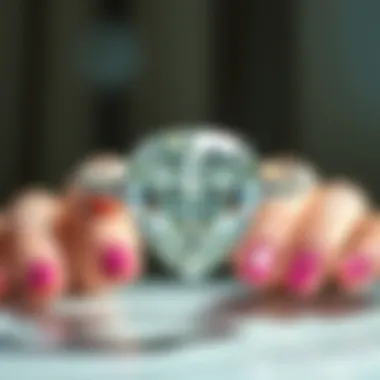
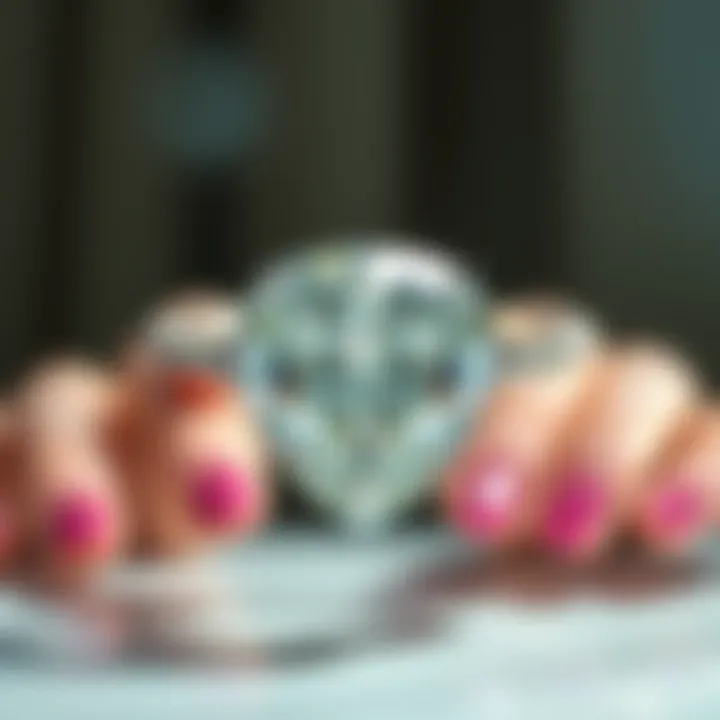
In the world of diamonds, keeping those gems in their top-notch condition is a matter of both aesthetic appeal and intrinsic value. Professional cleaning methods are not just a luxury; they are an essential aspect of diamond care. When entrusted to experts, these methods utilize advanced technology and specialized tools that can delve deep into even the tiniest crevices of your jewelry. This ensures that your diamonds don’t just shine but gleam with the kind of brilliance that catches the eye.
But what exactly sets these professional techniques apart from at-home cleaning? It primarily boils down to efficiency and thoroughness. While homecare methods might scrape the surface, professionals have access to equipment that can strip away years of built-up grime without risking any damage to your precious stones.
Ultrasonic Cleaning
Ultrasonic cleaning utilizes high-frequency sound waves to oscillate a solution around the diamond, effectively dislodging dirt and debris that might be nearly impossible to clean otherwise. The mechanics behind this process involve creating millions of tiny bubbles in a cleaning solution, which implode upon contact with the dirt. This phenomenon, known as cavitation, allows ultrasonic cleaning to reach the most hidden nooks and crannies of complex jewelry settings.
"Ultrasonic cleaners are often regarded as the gold standard for deep cleaning, as they can restore your diamond’s sparkle in a matter of minutes."
This method is not only effective but also importantly safe for diamonds, given their hard nature. Nevertheless, it is crucial to err on the side of caution when it comes to softer gemstones or more delicate jewelry settings. A word to the wise: always consult a professional to ensure that your specific piece is suitable for ultrasonic cleaning.
- Benefits of Ultrasonic Cleaning:
- Quick and thorough cleaning process
- Access to hidden areas often missed by hand cleaning
- Restores the original brilliance without scratching the surface
- Safe for most diamond jewelry when performed by professionals
Steam Cleaning
Steam cleaning is another professional method widely recognized for its effectiveness in restoring diamond brilliance. This technique involves injecting high-pressure steam into the jewelry, which helps dislodge dirt, oils, and residue accumulated over time. One of the most appealing aspects of steam cleaning is its efficiency—it's a quick solution that often requires no added chemicals, making it an environmentally friendly choice.
In a typical steam cleaning session, the jewelry is placed in a specialized machine that generates steam. The rapid movement of the steam effectively cleans dirt without any abrasive action. After the steam treatment, stones often look as clean as the day they were set.
- Considerations for Steam Cleaning:
- Ideal for removing oils and dirt without chemicals
- Not suitable for porous stones or jewelry with fragile settings
- Best carried out by professionals to avoid potential mishaps
Whether you opt for ultrasonic or steam cleaning, consulting a jewelry professional can give insight tailored to your diamond's specific needs, ensuring that each cleaning session maximizes brilliance while safeguarding the integrity of your exquisite piece.
Basic At-Home Techniques
When it comes to maintaining the luster and clarity of diamonds, utilizing basic at-home techniques can be an effective approach for many jewelry owners. The significance of these techniques lies in their simplicity and accessibility, making diamond care a feasible task without the need for expensive equipment or professional services. Properly cleaning your diamond jewelry at home ensures that it retains its beauty and integrity, enhancing its sparkle even in the absence of professional tools.
Use of Mild Soaps and Warm Water
One of the most straightforward methods for cleaning diamonds involves the use of mild soaps and warm water. This technique stands out for its safety and efficacy, eliminating the risk of scratching the stone or damaging the setting.
- Start by filling a bowl with warm water. The warmth helps to dissolve dirt and oil buildup without affecting the diamond.
- Add a few drops of a gentle detergent, such as a pH-balanced dish soap. Avoid any harsh chemicals that might tarnish other metals or make the diamond look dull.
- Gently drop your diamond jewelry into the soapy solution and let it soak for about 15 to 20 minutes.
- After soaking, use a soft cloth or a cotton pad to wipe down the surface, ensuring you reach all angles.
- Rinse the jewelry under lukewarm water to wash away any soap residue, and finish by drying it with a clean, lint-free cloth.
It's vital to ensure that the drain is plugged or that you're working over a soft surface while rinsing. The last thing you want is to watch a cherished piece slip away.
Remember, regular cleaning with mild soap and warm water helps maintain the brilliance of your diamonds.
Soft-Bristled Brushes
Utilizing soft-bristled brushes also plays a critical role in diamond care, particularly in hard-to-reach areas such as the underside of the stone. Using the right brush not only aids in removing dirt but also preserves the integrity of the diamond and its setting.
- Choose a brush that is soft enough to avoid scratching the surface but firm enough to remove built-up grime. Toothbrushes specifically designed for children or makeup brushes typically serve this purpose well.
- Lightly dip the brush in your soapy water solution, ensuring it’s damp, not soaking. Gently scrub the diamond, paying attention to intricate settings or crevices where dirt may accumulate.
- After brushing, rinse the diamond as outlined before, making sure to thoroughly remove any soap remnants.
Combining the mild soap method with a soft-bristled brush creates a winning combination. It’s akin to giving your diamonds a gentle scrub-down without the risk that harsher tools might introduce. With these techniques, regular maintenance becomes no more complicated than washing your hands.
Plainly put, adopting these basic at-home methods can effortlessly keep your diamond jewelry shining, ensuring they sparkle like new every time you wear them.
Cleaning Solutions for Diamonds
When it comes to caring for diamonds, selecting the right cleaning solutions can make all the difference. Different methods work better for different kinds of dirt and smudges, so knowing what’s available is essential. It’s not just about removing grime; it’s about maintaining the diamond's luster and clarity long-term.
Recommended Store-Bought Cleaners
Store-bought cleaners designed specifically for diamonds are widely available and can offer a convenient solution for many jewelers and collectors. These products often come in a range of formats, including sprays, dips, and wipes. Here are some notable points about them:
- Effectiveness: These cleaners typically contain a mix of chemicals tailored to target oils and debris without damaging the diamond's surface.
- User-Friendly: Many products are easy to use, requiring just a spray or a dip, followed by a gentle wipe or rinse.
- Convenience: Store-bought solutions are usually quick and hassle-free, allowing for immediate sparkle restoration without prepping anything at home.
Some recommended brands include Gemcare and Connoisseurs, which are well-rated for their ability to revitalize diamonds effectively. However, it's crucial to follow the instructions closely to avoid any unintended consequences, like overuse or inappropriate application.
Homemade Cleaning Mixtures
If you prefer a more personalized touch, homemade cleaning mixtures can be just as effective as commercial cleaners. They often combine simplicity and safety, using readily available ingredients. Here are a few favorite recipes:
- Soapy Water Solution:
- Baking Soda Paste:
- Vinegar and Water:
- Mix a few drops of mild dish soap with warm water.
- Soak the diamond jewelry in the solution for about 20-30 minutes. Then, gently scrub with a soft-bristled brush to get into those tiny crevices.


- Create a paste using baking soda and a few drops of water.
- Apply with a soft cloth, then rinse thoroughly.
- Combine equal parts of white vinegar and water for a natural cleaning solution.
- Soak the jewelry and then rinse with water to remove residues.
While these homemade solutions are effective, always remember to test a small area first. Some individuals worry about the acid content in substances like vinegar, but when diluted properly, it is generally safe. Ensuring that what you use will not scratch or dull your precious diamonds is paramount.
“The care and cleaning of diamonds can often reflect one’s understanding of their value and beauty.”
Being resourceful with what you have at home not only contributes to your diamond’s longevity but also provides an opportunity to engage more personally with your jewelry. In summary, whether you opt for store-bought or homemade solutions, prioritizing safe and effective practices when cleaning diamonds ensures that their brilliance never fades.
Avoiding Common Mistakes
Cleaning diamonds might seem straightforward, but many people stumble over common pitfalls that can detract from their jewelry's sparkle or even cause damage. Understanding these mistakes allows diamond owners to protect their valuable pieces more effectively. This section sheds light on what to dodge while cleaning and maintaining diamonds to preserve their brilliance.
Harsh Chemicals to Avoid
When cleaning diamond jewelry, it can be tempting to reach for the strongest cleaners thinking they’ll do a better job. However, certain harsh chemicals can do more harm than good.
- Chlorine: Often found in swimming pools and household cleaners, chlorine can easily dull the surface of a diamond over time.
- Bleach: While it's good at killing germs, its strength can erode the settings holding the diamonds in place, leading to potential loss of stones.
- Abrasive Cleaners: Any type of cleaner that has gritty particles, like baking soda, should be avoided as they can scratch the metal and the stone.
- Acidic Solutions: Products that are highly acidic can actually eat away at the metal settings; this includes some vinegar-based solutions.
"Diamonds are tough, but they aren’t invincible – care should be taken to prevent any degradation."
Using cleansers that are specifically formulated for diamonds is a wise decision. Look for labels that mention 'gentle' or 'safe for fine jewelry.' This will ensure that you maintain the piece's clarity without risking damage from caustic agents.
Improper Tools and Techniques
Using the wrong tools and techniques can lead to unsatisfactory results or worse, damage. Here are some common missteps:
- Using Toothbrushes with Hard Bristles: It might feel like a good idea to scrub your diamond with a toothbrush for stubborn dirt, but stiff bristles can scratch delicate metals or loosen the stone.
- Scrubbing Too Hard: The idea might be to scrub away every speck of dirt, but too much force can compromise the integrity of the metal setting where the diamond is placed.
Instead, use soft-bristled brushes or cloth specific for jewelry cleaning.
- Cleaning Too Often: Over-cleaning can wear down protective coatings of certain metals and lead to tarnishing. Finding a balance is key; a quick rinse after wearing for a day or two is generally sufficient.
- Ignoring Professional Help: Some might think they can handle everything at home, but if there are noticeable damages or if the diamond is heavily soiled, seeking a jeweler’s help is wise.
By being aware of common cleaning errors, owners can significantly prolong the life and beauty of their diamonds. Proper methods will maintain their shine and keep those gems looking as good as new.
Routine Maintenance for Diamonds
When it comes to ensuring the longevity and brilliance of your diamond jewelry, routine maintenance can't be overlooked. Unlike ordinary items that may merely gather dust, diamonds are susceptible to daily wear and tear from the environments in which we live. Establishing a regular cleaning schedule and maintaining vigilance about the condition of your pieces can make all the difference in preserving their stunning appearance. Regular attention contributes not just to the visual appeal, but also to the structural integrity of the stones.
The benefits of routine maintenance stretch far and wide:
- Enhanced Sparkle: Dirt and oils accumulate over time, dulled by mundane activities. Frequent cleaning restores the shine and luster, ensuring that your diamond sparkles in the light.
- Prolonged Life: Just like a well-cared-for vehicle, a diamond that receives routine checks and maintenance is likely to have a longer lifespan. Neglect can lead to damage that perhaps could've been avoided.
- Peace of Mind: Regular checks not only help maintain aesthetics but also offer reassurance that your precious ornaments are in good condition.
When handling diamonds, it's important to remember that prevention is often easier than treatment. A few minutes dedicated to care can save both time and money. For instance, when storing diamond jewelry, ensure they are separated from other pieces to prevent scratches and damages, which can often be a pain to rectify later on.
Frequency of Cleaning
So now, the gripping question: How often should you clean your diamonds? The answer isn't one-size-fits-all, and it can depend on how often you wear your jewelry. As a general rule of thumb:
- Daily Wearers: If you're wearing your diamond rings or earrings daily, a cleaning every two weeks is ideal. This interval ensures that oils and dirt do not build up excessively.
- Occasional Wearers: For those who do not wear their diamonds frequently, cleaning them once a month will suffice.
- Before Special Occasions: If you've got a big night out or a special event, it's advisable to give your diamonds a thorough clean just before. This will maximize their brilliance when they catch the light.
Checking for Damage
Further to the cleaning routine, checking your diamonds for any possible damages is equally vital. This is particularly crucial for settings that can sometimes loosen over time. Here are some indications that it might be time to take a closer look:
- Loose Stones: Gently tap your diamond to see if it feels secure in its setting. If there’s any movement, it might indicate wear and you should consider seeking professional help.
- Scratches and Chips: Inspect the stones for visible scratches or chips. A quick glance may be sufficient, but you might want to use a magnifying glass for a better view.
- Buildup in Settings: Sometimes dirt can accumulate in the prongs or settings, giving an unclear appearance. A quick inspection can help catch these before they become more serious issues.
"An ounce of prevention is worth a pound of cure."
By combining these tips of frequency in cleaning with a proactive eye on potential damage, you set your diamonds up for a shimmering future. Keeping your jewels in tip-top shape not only provides aesthetic rewards but also maintains their value, ensuring they remain as valuable in the future as their initial purchase.
Storing Diamonds Properly
Proper storage of diamonds is as crucial as cleaning them. When diamonds are not stored correctly, they risk scratches, damage, or even loss, which can significantly decrease their value. Diamonds may be the hardest natural substance, but that doesn’t mean they are immune to physical wear and tear or the adverse effects of their environment.
When it comes to ensuring the longevity and integrity of your diamond jewelry, you want to treat them like the treasures they are. Here are some important points to consider:
- Avoiding Damage: Improper storage can lead to nicks and scratches, not just on the diamond itself, but also on the metal settings. A little caution can prevent substantial issues in the future.
- Protecting Against Environmental Factors: Humidity, dust, and even the presence of other materials can affect the overall appearance of your diamonds.
- Maintaining Value: Well-maintained and properly stored diamonds hold their value significantly better than those that are neglected or poorly stored.
Safe Storage Practices
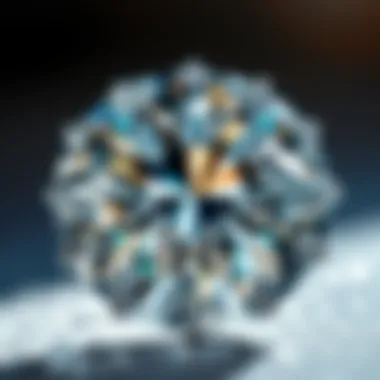
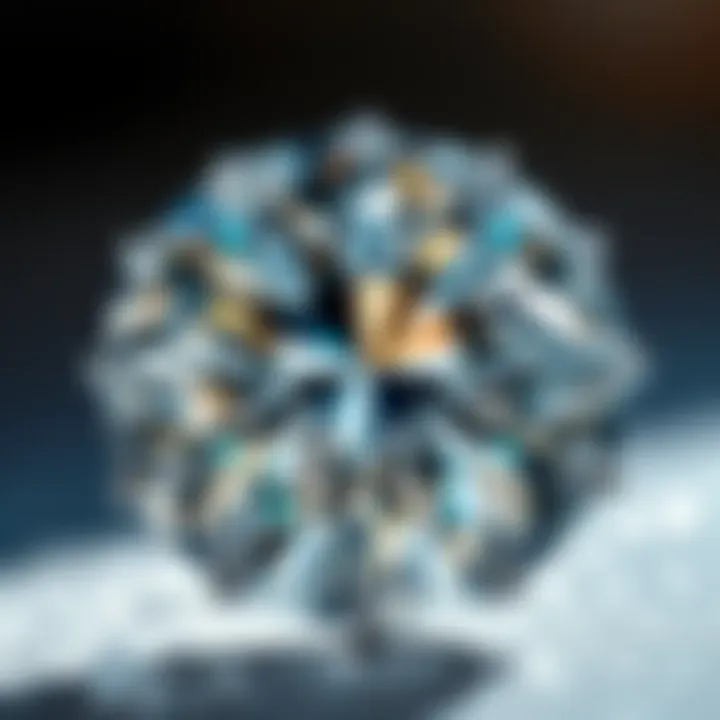
To create a refuge for your diamonds, it’s essential to adopt safe storage practices. Here are some strategies to keep in mind:
- Use a Soft Cloth or Pouch: When putting diamond jewelry away, use a soft cloth pouch rather than tossing it into a jewelry box. This practice helps to absorb moisture and eliminates the possibility of scratches.
- Individual Compartments: Store each piece separately, if possible. Compartmentalized boxes or drawers prevent different pieces from coming into contact, which could cause unwanted damage.
- Environmental Considerations: Store your diamonds in a cool, dry place. Extreme temperature fluctuations or high humidity can lead to negative side effects, such as tarnishing of settings or deterioration of materials.
- Safekeeping Options: For high-value pieces, consider a safe or a bank safety deposit box. This not only ensures protection from theft but also protects against potential disaster in a home.
Preventing Scratches and Damage
To keep your diamonds looking as good as new, preventing scratches and damage is essential. Here are some tips to consider:
- Soft Linings: Ensure that the storage container is lined with a soft material like velvet or satin. This acts as a cushion, protecting against scratches when handled or jostled.
- Avoid Mixing with Other Jewelry: Don’t store your diamonds along with other jewelry, especially those made of softer metals or with gemstones that could create friction and scratches.
- Regular Checks: Every now and then, inspect your stored diamonds for any potential damage. Check for loose settings or any changes in appearance that could indicate wear and tear.
- Educate Yourself on Storage Needs: Learn about specific needs for types of diamonds you own. Some may require unique well thought-out conditions that are tailored to their individual characteristics.
"Proper care isn't just an effort; it’s an investment into the future brilliance of your diamonds."
Understanding the Impact of Environment
When it comes to keeping diamonds in pristine condition, the environment plays a pivotal role. Understanding how various environmental factors like humidity, temperature, and exposure to other jewelry can influence your diamond’s cleanliness and overall appearance is crucial. This section aims to illuminate the effects of these environmental elements while offering practical strategies for preserving your diamond's integrity and sparkle.
By recognizing how these factors interact with your gems, you can make informed decisions about how to care for and protect your treasured pieces.
Humidity and Temperature Effects
Humidity levels can greatly impact the cleanliness and brilliance of diamonds. High humidity can foster moisture retention which sometimes leads to dirt and grime buildup on the stone. Conversely, extremely low humidity can cause dehydration in certain adhesives used in settings, potentially compromising the integrity of your diamond. Therefore, maintaining a balance is key.
Consider the following points:
- Optimal Conditions: Aim for a humidity level between 30% to 50%. This range helps to prevent moisture retention while minimizing harm to settings, especially those involving glues.
- Temperature Sensitivity: Diamonds can resist extreme cold and heat, but sudden temperature changes can cause stress on both the stone and the mounting. Try to store your jewelry in a consistent environment, away from temperature fluctuations that could jeopardize the piece.
"Diamonds are relatively tough, but their settings may not share this resilience. Keeping an eye on environmental conditions can save you heartache later."
A few simple precautions can go a long way in preventing unwanted outcomes:
- Store jewelry in a climate-controlled setting.
- Avoid exposing diamonds to high-heat sources like grills or open flames.
- Be cautious about where you wear your jewelry. Activities in high humidity, such as swimming or exercising, can lead to excessive build-up of sweat and dirt.
Contact with Other Jewelry
The company that diamonds keep can also dictate their condition. Contact with other pieces of jewelry, especially those made of different materials, increases the potential for scratches and dullness. Though diamonds are one of the hardest materials on Earth, their settings often aren't.
Here’s what to keep in mind regarding jewelry storage and handling:
- Separate Storage: Keep diamonds away from other pieces, particularly those made from softer metals or stones. Using jewelry boxes with individual compartments or soft pouches can help avoid any unwanted interactions.
- Be Mindful During Wear: Avoid wearing multiple rings on the same finger, as this can lead to knocking against each other, causing potential scratches or wear over time.
- Regular Inspections: Make it a habit to routinely check for signs of wear and tear caused by contact with other jewelry. Detecting issues early can prevent more significant problems down the line.
Maintaining the splendor of your diamonds is about being proactive, understanding the nuances of their environment. By managing these aspects effectively, you can ensure that your diamonds continue to shine, marveling anyone who lays eyes on them.
Expert Tips for Diamond Care
Taking proper care of diamonds is crucial for maintaining their allure and longevity. In this section, we will explore practical tips that can help ensure that your diamonds remain as dazzling as the day you acquired them. The importance of these expert suggestions cannot be overstated, especially for those who appreciate fine jewelry and its value. By implementing these strategies, diamond owners can prevent common issues related to dirt accumulation, damage, and fading brilliance.
When to Seek Professional Help
While regular at-home cleaning can keep your diamonds looking good, there are times when you might need to call in the pros. If your diamond is showing signs of severe tarnish or if there are scratches and chips, it’s worth consulting with a gemological expert. This can make a world of difference in restoring your jewel's original sparkle. Look for signs such as:
- Flaws that aren't resolving with basic cleaning
- Loose settings which can lead to potential loss of the stone
- Any discoloration that seems persistent despite cleaning efforts
Having a professional assess your diamond occasionally ensures that any underlying issues are addressed, and prevents larger problems down the road.
"It’s better to be safe than sorry; a little attention now can save a lot of heartache later."
Long-Term Care Strategies
Maintaining diamonds goes beyond just cleaning. There are strategies that can be employed to ensure their long-term care. Here are a few tips that you might find useful:
- Regular Inspections: Check your diamond settings often. A lost stone can’t be replaced if it’s oxidized or damaged.
- Storage Solutions: Store your diamonds in separate pouches or compartments to avoid scratches. The less they bang against other pieces, the better.
- Avoiding Contact: Make it a habit to take rings off before engaging in activities that might expose them to harsh conditions, like gardening or cleaning with chemicals.
- Professional Appraisals: Get your diamonds appraised regularly to understand their current market value, which can help in determining insurance needs.
Implementing these long-term strategies not only prolongs the life of your diamonds but also keeps them looking their very best.
Understanding and applying expert tips for diamond care can truly make a difference in how these precious rocks are maintained, keeping their value high and sparkle intact.
Epilogue
In wrapping our exploration of diamond cleaning, it’s abundantly clear that understanding proper care for these precious gems is essential not just for aesthetic appeal but also for maintaining their value. Ensuring your diamonds are regularly cleaned and properly stored can make a substantial difference, enhancing their brilliance and keeping them sparkling for years to come. A clean diamond is a happy diamond, so to speak. Without this diligence, your cherished pieces may lose their luster, which is something any gemstone lover would want to avoid.
Recap of Effective Cleaning Practices
To reiterate, there are several effective cleaning practices that can help keep your diamonds in pristine condition. Here are a few highlights:
- Basic At-Home Techniques: Using mild soap and warm water can work wonders. Remember to gently scrub with a soft-bristled brush to remove any stubborn grime.
- Professional Solutions: Don't hesitate to enlist professional cleaning methods, such as ultrasonic or steam cleaning, especially for intricate settings where dirt tends to accumulate.
- Regular Maintenance: Frequent inspections not only include cleaning but also checking for damages. Identifying loose stones or worn settings can save you a world of troubles down the line.
- Safe Storage Practices: Store diamonds away from other jewelry to prevent scratches and potential damage. Simple velvet pouches or dedicated jewelry boxes can go a long way.
"The time you invest in taking care of your diamonds truly pays off in the long run."
The Importance of Proper Diamond Care
Caring for diamonds is more than just a matter of aesthetics; it’s about respecting their value and ensuring they remain a beloved part of your collection. Proper care, in essence, prolongs their lifespan. Each diamond tells a story, and regular maintenance ensures that those stories can be shared for generations.
Investing a little bit of time into understanding your diamonds and how to keep them clean can result in significant rewards. Not only does this protect your investment, but it also enhances the enjoyment of owning these exquisite gems. A diamond you can confidently wear, knowing it is clean and well-cared-for, allows for a more fulfilling experience.







